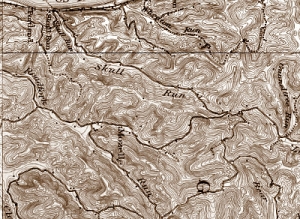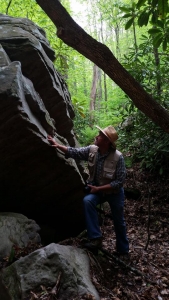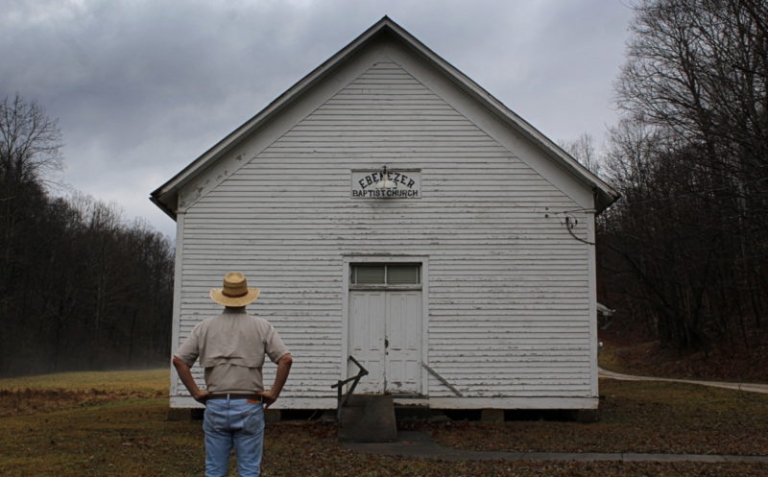SKULL RUN, W.Va. — A traveler motoring through the pastures in this wooded section off the Ohio River might have little idea of the dark tales that have arisen there. With its grazing cattle, it seems a world away from warfare, but according to the late historian Nathan Goff Carder, its red clay isn't all that bloodies the stream red after a rainstorm.

According to Carder, in 1790, an otherwise undocumented battle erupted at the head of the run off the Ohio River. There, a small group of natives led by Irish pioneer Zeri Kidlow fought off an attack from Shawnee.
Kidlow had escaped debtor's prison and was floating down the Ohio River on an evening in 1781 when he spotted the embayment at the mouth of Skull Run and decided to investigate.
"Only a short distance up the hollow, he spied an inviting little inlet, or niche, in the hillside," Carder wrote. "Finding, on the morrow, that the stronghold was indeed a retreat from civilization, Zeri set about building a cabin."
Despite the threat of attack by unfriendly Native American groups, Kidlow prospered in the little hollow where he began to distill poteen from potatoes and became friendly with local natives. A medicine man established a camp near Kidlow's cabin "and an old man who made arrowheads moved into a tee-pee nearby," according to Carder:
"The little hollow soon became a great social gathering place for all families and bands of Indians friendly to those on Skull Run. Zeri's still had wrought a singular service and organized an alliance more effectively than modern-day diplomacy or eloquence. Indians came from miles and miles around to purchase firewater. Zeri had the distinction of being the first saloon keeper in what is now Jackson County."
However, peace and prosperity on Skull Run did not long survive, Carder wrote, and "displaced persons from the rapidly expanding English settlements of Virginia crossed the Blue Ridge Mountains looking for hunting grounds further west."
"Strange Indians were seen skulking along the Ohio, and painted warriors began to descend from Milhoan Ridge threatening the safety of these happy, peace-loving people on Skull Run. Scouting parties were sent out for reconnaissance. Soon word arrived of a great horde of Indians moving in from the northeast and taking possession of the land and scalping women and children. The situation grew desperate."

Kidlow and his companions chose to confront the Shawnee at the head of the hollow at the "Low Gap" the led into the valley of Little Pond Creek. There the opposing sides battled with fists and tomahawks until Kidlow, hidden high in an oak, let loose a barrage of profanities that Carder claims spooked the Shawnee.
Read Also: Pirate treasure hidden along Ohio River may be lost for good; Wreck of the steamer Rebecca occurred Dec. 7 on Ohio
"Once concealed at this lofty eminence, he released a withering blast of scorching, devastating profanity to east, to the west, and all directions between," Carder wrote.
"It's strange how readily the English language lends itself to profane eloquence when the cause is a just one."Though the battle was won, Kidlow, upon returning home, found his wife wounded and his son decapitated and "swore by his beard and by the shades of all Irish deities" to avenge the death.
Though his native companions forgot the battle, Kidlow developed a bloodlust, and would return from manhunts with the heads of Shawnee victims.
"For years the old head-hunter collected these ghastly trophies," Carden wrote. "The hillside to the right of this cabin soon became lined with human visages in all stages of decay."
The Shawnee, however, were impressed, and named him "Chief Skull" — "Catawaypetheaway Okemah," according to Carden.
Kidlow lived to a ripe old age among his adopted people until he was struck and killed by lightning on October 12, 1802, at a spot Carden describes as being in the Blackamoore Graveyard. Afterward, he was buried beneath a pyramid of skulls, the remnants of which were found by settlers, who named the stream and valley "Skull Run."
Whether Carden's tale is true is a subject of much speculation, and he cites no sources for his work. However, his tales are considered valuable to local enthusiasts.
His tale of Skull Run, along with other local histories, was collected by Appalachian Wordsmith and published by Star Printing Co., of Ravenswood, West Virginia, with a grant made possible by the Bernice Pickens Parsons Foundation. The publication and all proceeds are property of the Jackson County Public Library.
Sign up to receive a FREE copy of West Virginia Explorer Magazine in your email weekly. Sign me up!





























